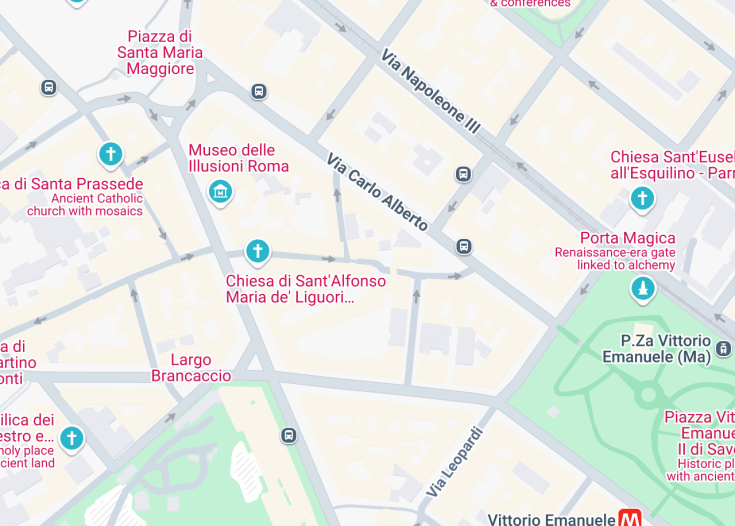The Arch of Gallienus, also known as the Porta Esquilina, is a remarkable ancient Roman arch located within the Servian Wall of Rome, Italy. This monumental structure, dating back to the Augustan era, signifies a pivotal gateway that once connected vital roads leading from the city, highlighting its architectural grandeur and historical importance.
Visitors should take the time to explore the surrounding area of the Arch of Gallienus, as it provides a fascinating glimpse into the blend of ancient architecture and modern urban life, showcasing Rome’s rich historical tapestry.
Consider visiting during early morning or late afternoon to avoid the crowds. This allows for a more intimate experience as you admire the Arch of Gallienus and immerse yourself in the captivating atmosphere of ancient Rome.
Architectural Significance of the Arch of Gallienus in Rome, Italy
The Arch of Gallienus, also known as Porta Esquilina, represents a blend of historical architecture and cultural significance. Located within the Servian Wall, this ancient Roman arch was initially constructed as a gateway during the Augustan period, exemplifying Roman engineering techniques of the time. The arch stands at an impressive height of 8.80 meters, with a width of 7.30 meters, and is constructed primarily of travertine. The structure is supported by robust piers measuring 1.40 meters across and 3.50 meters in depth, embodying both strength and aesthetic appeal. The arch features Corinthian pilasters that enhance its grandeur, while a horizontal entablature rests above the central archway. Notably, it displays a dedicatory inscription commissioned by Marcus Aurelius Victor in 262 AD, which pays homage to the emperor Gallienus and his wife, Salonina. This inscription was intended to improve Gallienus’ reputation during a difficult period of his reign, thus reflecting the political nuances of the era. The current state of the structure, mainly the single surviving arch, is a testament to its resilience through centuries, despite the demolition of two smaller pedestrian passages in the 15th century. Today, the Arch of Gallienus stands not only as a pivotal historical monument but also functions as a captivating focal point for visitors exploring the ancient pathways that once led to significant Roman roads such as the Via Labicana and Via Tiburtina.
Historical Overview
Ancient Origins
The Arch of Gallienus dates back to the Augustan era, serving initially as a gateway in the Servian Wall of ancient Rome. Its construction reflects the grandeur of early Roman infrastructure, where it provided access to vital roads leading from the city, integral for trade and transport.
Rededication in 262 AD
The arch underwent a significant transformation in 262 AD when it was rededicated by Marcus Aurelius Victor in honor of Gallienus and his wife. This act was notable for its political implications, aimed at restoring Gallienus’s image amidst external pressures and military setbacks the Empire was facing.
Medieval and Renaissance Context
During the late antiquity and subsequent medieval periods, the Arch of Gallienus became associated with the emerging Christian community, ultimately being positioned adjacent to the church of San Vito. The structural integrity of the arch continued to draw attention, although, in the 15th century, some of its original features were lost due to renovations.
Exploring the Area Around the Arch of Gallienus in Rome
The vicinity of the Arch of Gallienus offers visitors an intriguing glimpse into the bustling life of ancient Rome. The nearby Clivus Suburanus, once a focal point for trade and social gatherings, is lined with remnants of historic taverns and shops. Visitors can explore the bustling atmosphere, which highlights the everyday life of Romans. The arch serves as a backdrop to urban scenes, allowing for photographic opportunities that capture the layered histories of the city.
The Arch’s Inscription and Its Historical Context
An essential feature of the Arch of Gallienus is its dedicatory inscription, which not only honors Gallienus but also reflects the political climate of the 3rd century AD. The brief inscription suggests an image of the emperor as a benevolent leader, attempting to secure loyalty and admiration during his reign, plagued by military anxieties. This rhetorical flourish serves as a striking reminder of how public monuments were strategically used in political discourse.
General informations
Location
The Arco di Gallieno is located in the Esquilino district of Rome, Italy, accessible via the busy thoroughfare of Via San Vito. This ancient arch is situated close to notable landmarks such as the Basilica di Santa Maria Maggiore and the Termini railway station.
Address:
Via di S. Vito, 00185 Roma RM, ItalyVisiting Information
The Arch of Gallienus is open to the public without any specific closing hours, allowing visitors to appreciate this monumental structure at their leisure. Early mornings or late afternoons offer a tranquil atmosphere, ideal for observing the arch’s intricate features and capturing photographs.
How to reach the Arco di Gallieno
Car
The Arco di Gallieno is conveniently reached by car, with parking options available nearby for a nominal fee. Various parking lots and structures can accommodate visitors.
| Route | Distance | Travel time |
|---|---|---|
| From Fiumicino Airport | 30 miles (48 Km) | 40 minutes |
| From Vatican City | 3.5 miles (5.6 Km) | 15 minutes |
| From Trastevere | 5 miles (8 Km) | 20 minutes |
Public Transport
The Arch of Gallienus is also accessible via public transport. Visitors can take the metro or bus services from various parts of the city.
- Metro: Closest station is Termini (Line A and B), approximately a 10-minute walk from the arch.
- Bus: Several bus lines stop at Via Merulana, just a short distance from the location.
Accessibility and Limitations
The Arco di Gallieno is accessible to most visitors; however, the surrounding areas may have restrictions for individuals with mobility challenges due to the uneven pavement.
Accessibility
Limitations
- Limited seating areas nearby.
- Crowded conditions during peak tourist seasons.
- Uneven terrain surrounding the arch.
Notes to visitors
- Parking may be limited on busy days.
- Guests are encouraged to minimize noise to respect the historical significance of the site.
- Pets are not allowed near the arch.
Common questions
What architectural features can I see at the Arch of Gallienus?
The Arch of Gallienus, also known as the Porta Esquilina, showcases several notable architectural features that reflect its ancient Roman design. The surviving structure is a single arch made from travertine, standing at 8.80 meters in height and 7.30 meters in width. In its current form, the arch has a rectangular shape, consisting of strong piers that are 1.40 meters wide and 3.50 meters deep. Each pier is complemented by two pilasters, adorned with Corinthian capitals, creating an elegant appearance.
Above the arch itself is a horizontal entablature, which is approximately 2 meters high. This section contains a dedicatory inscription that celebrates the arch’s rededication to Emperor Gallienus and his wife, Salonina. The ornate cornice beneath the spring of the arch further highlights its architectural significance, while detailed drawings from the 15th century indicate that it once featured small side arches, which were unfortunately demolished in the 15th century.
Visitors can appreciate both the grandeur and simplicity of this ancient monument, which has endured through centuries of history and change, making it an integral part of Rome’s architectural heritage.
What can I do near the Arch of Gallienus?
The area surrounding the Arch of Gallienus is rich in history and offers numerous activities for visitors. One of the most popular nearby attractions is the Basilica di Santa Maria Maggiore, one of the four major basilicas of Rome, which stands just a short walk away. This stunning basilica is renowned for its beautiful mosaics and intricate architecture, providing an excellent opportunity for exploration.
Another significant site nearby is the Santa Croce in Gerusalemme, a church known for its collection of relics and impressive twelfth-century architecture. After visiting these historical sites, visitors can stroll through the charming streets of the Esquilino neighborhood, where you can find local shops and cafes, making it a perfect spot for enjoying traditional Roman cuisine.
The nearby Mercato di via Papero is also worth a visit, as it offers a variety of fresh produce and local delicacies, allowing you to immerse yourself fully in Roman daily life. Overall, the vicinity of the Arch of Gallienus offers a delightful blend of history, culture, and culinary experiences for every visitor.
What are the best times to visit the Arch of Gallienus?
The Arch of Gallienus is an impressive historical site that can be enjoyed throughout the year, but certain times may enhance your experience. For many visitors, early morning or late afternoon is ideal for visiting. During these times, the lighting is softer, providing beautiful photo opportunities with fewer distractions from crowds. Visiting in the morning is often recommended, as the air is cooler and the sun casts a lovely glow on the ancient structure.
Spring (April to June) and fall (September to October) are particularly lovely times to tour Rome, including the Arch of Gallienus. During these months, the weather is usually pleasant, with mild temperatures, making it comfortable to explore the outdoor surroundings without the sweltering heat of summer. Additionally, during these seasons, you’re likely to face fewer tourists, providing a more serene atmosphere to appreciate this majestic piece of Roman architecture.
No matter the time of year, visiting the Arch of Gallienus should be complemented by other nearby attractions and experiences, making each visit unique and memorable.
Are there any guided tours available for the Arch of Gallienus?
Yes, there are several guided tour options available for visitors interested in exploring the Arch of Gallienus and its surroundings. Many tour companies in Rome offer specialized walking tours that include the Arch of Gallienus as part of a broader historical itinerary, focusing on Ancient Rome or architectural highlights in the city. These guided tours provide insightful commentary on the arch’s significance, history, and architectural style, enhancing your understanding of this fascinating structure.
In addition to walking tours, some companies also offer combined tickets that include entrance to multiple nearby attractions, allowing you to discover more of Rome’s incredible heritage without the hassle of purchasing individual tickets. An expert guide will help you navigate the areas around the Arch of Gallienus, ensuring you don’t miss any historical context or hidden gems along the way. This is an excellent option for those who prefer structured exploration with the added benefit of insider knowledge.
Be sure to check various tour providers for availability, and consider booking in advance, especially during peak tourist seasons, to secure your spot on a guided adventure of Rome.
What nearby attractions complement a visit to the Arch of Gallienus?
Visiting the Arch of Gallienus allows you to explore a wider range of historical and cultural attractions in the vicinity. Just a short walk away is the renowned Basilica di Santa Maria Maggiore, one of the largest and most important basilicas in Rome, noted for its stunning mosaics and rich history.
Another significant site nearby is the Colosseum, an iconic symbol of Ancient Rome. This monumental amphitheater is a must-see for anyone visiting the city. You can also consider stopping by the Palatine Hill and Roman Forum, both within walking distance of the Arch, where you can delve deeper into the history of the Roman Empire.
For those interested in local life and culture, the Esquilino neighborhood itself offers an array of shops, culinary delights, and markets. The Mercato di via Papero is a great spot to experience local Roman cuisine, while the nearby gardens of Villa Celimontana provide a beautiful park setting to relax after exploring the rich history of the area.
Overall, the Arch of Gallienus serves as a wonderful starting point for an unforgettable day’s exploration of Rome’s ancient heritage and vibrant neighborhoods.

Is the Arco di Gallieno in Rome (Rome), Italy worth visiting?
The Arch of Gallienus, also known as the Porta Esquilina, is a significant historical landmark that provides insight into the architectural practices of ancient Rome. Although it may not be as renowned as the Colosseum or the Roman Forum, it holds its own charm, particularly for those interested in Roman history and architecture.
Standing as a remnant of the Servian Wall, this arch was originally reconstructed in the Augustan period and later rededicated to Emperor Gallienus. Its historical significance, coupled with its striking Corinthian pilasters and intricate inscriptions, makes it an interesting stop for tourists.
While visiting, you can appreciate the quieter atmosphere away from major tourist crowds, allowing for a more reflective experience with Rome’s rich past.









